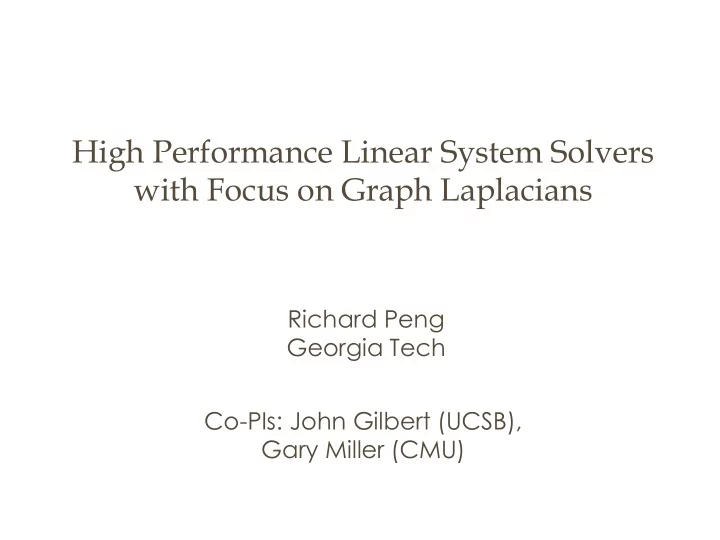

High Performance Linear System Solvers with Focus on Graph Laplacians Richard Peng Georgia Tech Co-PIs: John Gilbert (UCSB), Gary Miller (CMU)
OUTLINE • Problem of Lx = b • Benchmarks and Evaluations • Tree Based Solvers
GRAPH LAPLACIANS Matrices that correspond to undirected graphs 1 2 -1 -1 -1 1 0 -1 0 1 1 • Variables vertices • Non-zeros edges
SOLVING Lx = b • Multigrid methods widely used in scientific computing • Good runtimes for systems with as many as 10 9 nonzeros • MATLAB: pcg( L , ichol( L ), b , ε) ‘works’ for 10 6 nonzeros • [ST`04]: O(mlog c nlog(1/ ε )) time • 2004 – 2014: c halved every 2 years 70 32 loglogc: 15 1/2 6 2 1 year: 2014 2004 2006 2008 2009 2010 2011
THE LAPLACIAN PARADIGM Directly related : Elliptic systems Few iterations : Eigenvectors, Heat kernels Many iterations / modify algorithm Graph problems Image processing
NEW WAYS OF USING SOLVERS Sequence of (adaptively) Problem generated linear systems: • Power iteration • Interior point method • Iterative least squares Lx=b What makes such L and b hard: • Widely varying weights • Multiscale behavior • Difficulties of the graph problems
OUTLINE • Problem of Lx = b • Benchmarks and Evaluations • Tree Based Solvers
[KRS`15]: ISOTONIC REGRESSION README file we suggest rerunning the program a few times and / or using a different solver. An alternate solver based on incomplete Cholesky is provided with the code. https://github.com/sachdevasushant/Isotonic
GOAL: BENCHMARKS Structured graphs • Grids / cubes • Cayley graphs • Graph products Hard graph problems • Maxflow problems from DIMACS implementation challenges • Linear systems arising from second- order optimization (IPM)
NUMERICS + COMBINATORICS: Numerical methods (e.g. CG) rely on preconditioners • Good approximation to L • Easy (easier) to solve on Spanning trees: • finite approximation • linear time solve
NUMERICS + COMBINATORICS Conjugate gradient (CG) with tree preconditioner: • [textbook]: m 1/2 iters, even with round-off errors • [SW`09]: with exact arithmetic, takes m 1/3 iters Better convergence using 1024 bit MPFR floats compared to 53 bit C++ double https://github.com/serbanstan/TreePCG https://github.com/danspielman/Laplacians.jl
QUESTION: NUMERICAL PRECISION • Can numerical precision be analyzed through the graph theoretic components? • Primal-dual view of precision? CG? https://github.com/serbanstan/TreePCG https://github.com/danspielman/Laplacians.jl
OUTLINE • Problem of Lx = b • Benchmarks and Evaluations • Tree Based Solvers
GOAL: FAST TREE-BASED SOLVERS Gradually transform a tree-based solution to a solution on the entire graph Claim: these ideas lead to code that can solve any Lx = b with 10 9 edges in ≤ 10 seconds on ≤ 64 cores Method Cycle Toggle Ultrasparsifier Cost / Iter logn m + (m/k) 2 # Iters mlog 1/2 nlog(1/ ε ) k 1/2 log(1/ ε ) Related to SGD Grad. descent Step uses Data structures Mat-Vec multiply
CYCLE TOGGLING • Pick one off tree edge e at a time, make progress using T + e as preconditioner • Speed up calculations using data structures • [KOSZ `13]: akin to toggling dual flow along cycle, mlogn toggles, each costing O(logn) • [LS `13]: CG-like acceleration to O(mlog 1/2 n) toggles
AUGMENTED TREES • Add some edges to a tree to form a `batched’ preconditioner • Use exact methods on preconditioner • [Vaidya `91]: MST + edges • [KMP`10]: O(mlog 2 n/k) edges k 1/2 iters • Optimize: m 5/4 log 1/2 n Exists recursive versions, but those gains only kick in at around 10 9 edges
MOVING PIECES vs Method Cycle Toggle Ultrasparsifier Cost / Iter logn m + (m/k) 2 # Iters mlog 1/2 nlog(1/ ε ) k 1/2 log(1/ ε ) Related to SGD Grad. descent Step uses Data structures Mat-Vec multiply • Trees: MST / bottom-up / top-down / adaptive • Data structures: offline / static / dynamic • Numerics: batched / local, accelerated / CG • Initialization: tree solution / recursive
BENCHMARK FOR TREE BASED ALGOS: HEAVY PATH GRAPHS Pick a Hamiltonian path, weight all other edges so each has stretch 1 • Bad case for PCG, • `easy’ for tree data structures
CYCLE TOGGLING VS. PCG https://arxiv.org/abs/1609.02957 https://github.com/sxu/cycleToggling
VARIANTS OF CYCLE TOGGLING https://arxiv.org/abs/1609.02957 https://github.com/sxu/cycleToggling
THANK YOU • Collaborators: • Hui Han Chin (CMU), • Kevin Deweese (UCSB), • John Gilbert (UCSB), • Gary Miller (CMU), • Saurabh Sawlani (GaTech), • Serban Stan (Yale), • Haoran Xu (MIT), • Shen Chen Xu (CMU) • Repos & Papers: • https://github.com/sxu/cycleToggling • https://github.com/serbanstan/TreePCG • https://github.com/danspielman/Laplacians.jl • https://arxiv.org/abs/1609.02957
Recommend
More recommend